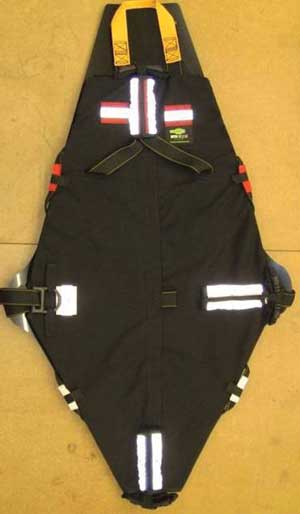By THOMAS J. FEE
The Rite Rescue Systems RAP (Remove and Protect) was invented by three firefighters who realized that not one piece of equipment on the market was designed to transport an unconscious firefighter. This multifunctional device offers tremendous versatility and several configurations.
If you encounter an incident’s worst-case scenario-a firefighter going down in the basement of a private dwelling-what do you use to move the victim? Most firefighters carry webbing to apply to the unconscious firefighter. Others may use a self-contained breathing apparatus (SCBA) waist belt to create a harness. The RAP litter can be used for this and much more.
 |
| (1) Photo by author. |
“Intuitive” best describes the RAP’s design features. All of the straps are stored inside a bag until your need to deploy the system. The T-handles, designed so they could be located with a gloved hand, are positioned on the face of the bag in pockets closed with a hook-and-loop fastener. After the straps are tightened, tuck away the T-handle so it is less likely to get hooked onto something during transport. The D-ring-also attached to the face of the bag-is oversized, making it easier to find in zero visibility.
When the waist snap-hook and D-ring are married, it creates a Class I harness. When you introduce the groin strap to the D-ring, it becomes a Class II harness. When you deploy the shoulder strap and hook it to the D-ring, it is now a complete Class III harness.
The RAP also introduces new and unconventional ways of packaging the down firefighter. After you locate the down member and are ready to remove him, place the RAP at his head and pull on the tab; the device will unroll itself. Put the unconscious firefighter face down in the RAP and secure the straps. When you reach the stairs, you can hook up your mechanical advantage and have members at the top pull him to safety. The RAP is the only device on the market that allows you to accomplish this operation.
The RAP’s greatest feature is the speed at which you can apply it to the victim. If one thing is critical in the fire service, it’s time. The RAP’s learning curve is so small that most first-timers are impressed with how quickly they learn how to use it. Thus, it is of tremendous benefit to your department’s officers.
Carrying the RAP is made easy with the grab loops on the sides. Two loops are at the head and two are at the bottom; this distributes the victim’s weight evenly in the device. Attached at the top are two- to 24-inch straps used for dragging, with a yellow lifting point fastened to them. Here, you can place the 2:1 mechanical advantage or a haul line for lifting. A revolutionary configuration of an inflatable bladder is tucked away on the inseam of the bag. It is held in position and protected with sleeves. The bladder is filled by a CO2 cartridge or by oral inflation. When filled, it produces 300 pounds of leverage. Furthermore, when it is inflated and the harness system is secure, it creates spinal immobilization for a trauma patient.
Rite Rescue Systems created its own patented base material, which allows the RAP to hold its form and deploy when used. The base holds no memory and can be changed when worn out. Color identification of the base allows you to use one color for drills and another for real-time use. Reflective tape placed at the top indicates where to place a victim’s head. This device can also be used when rescuing a civilian. For example, you can secure a small child to a large firefighter who is wearing SCBA.
Also, you can easily store the RAP on a rig. It’s rolled into a 10-inch-round tube 34 inches wide and weighs just eight pounds. It is recommended that it be kept with the rapid intervention team’s SCBA or in the stokes basket.
One example of the RAP’s effectiveness occurred during a situation on a parked airplane where a passenger had a heart attack. Three firefighters on the flight, who were going on a sales call, jumped into action and used a defibrillator and cardiopulmonary resuscitation to revive him. The firefighters placed the victim in the RAP, dragged him down the aisle, and lowered him down the plane’s stairs.
The RAP has passed and exceeded all testing requirements. It is Underwriters Laboratories-tested to NFPA 1983, Standard on Life Safety Rope and Equipment for Emergency Services, 2012 edition, as a litter, as a victim extrication device, and as a Class III life safety harness. It’s the only piece of equipment to hold all three certifications in one device.
● THOMAS J. FEE is the president of Rite Rescue Systems. He is a 15-year veteran of the Fire Department of New York and is a 25-year member of the Steamfitters Local Union 638.
Fire Engineering Archives

